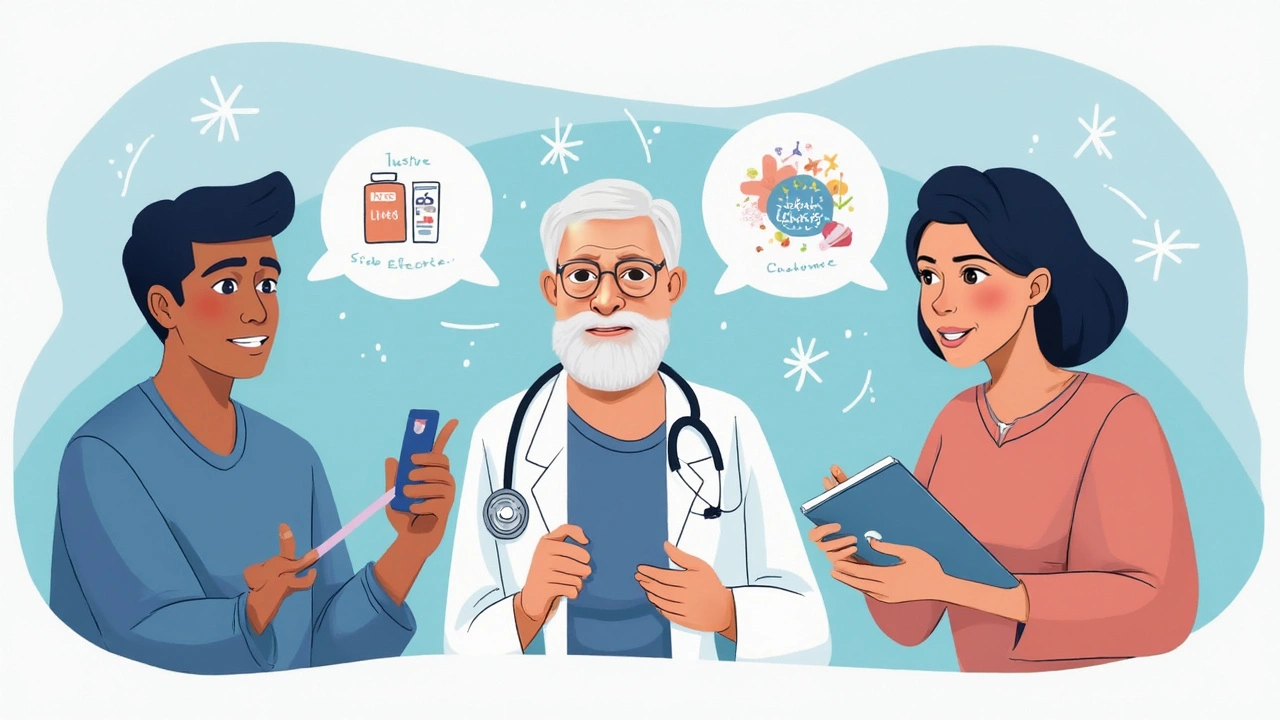Imagine a pill that’s a game-changer, but only for those who feel like nothing else has worked. That’s Clozaril, also known as clozapine. It’s not some everyday medicine you see on a pharmacy shelf. Instead, it’s more like that last card you'd pull out when you’re out of options. Back in the 1970s, researchers noticed something wild: Clozaril helped patients whose schizophrenia didn’t budge with other drugs. But the catch? It comes with rules, routines, and a boatload of monitoring. Still, for many families who’ve tried everything, Clozaril can mean the difference between relentless psychosis and actual daily living.
How Clozaril Turns the Tables on Toughest Schizophrenia Cases
This isn’t your average antipsychotic. Most people living with schizophrenia get placed on the standard meds—think risperidone, olanzapine, or quetiapine—and hope for the best. But if two or more of those throw up their hands and quit, that’s where Clozaril steps in. The reason doctors keep it as a last resort is because, while it’s powerful, it also comes with some serious risks. Yet, nothing else can beat its effect for the people it helps.
Here’s what makes Clozaril stand out: It latches onto brain receptors differently than regular antipsychotics. It targets both dopamine and serotonin but also some other pathways. The practical outcome? It slashes the intensity of hallucinations and delusions in people who are "treatment-resistant," which is clinical speak for "every other med failed." Weirdly, it’s also the only drug proven to reduce suicidal behaviour in people with schizophrenia. That’s rare in psychiatric meds.
But you don’t mess around with Clozaril. It’s not just the standard prescription and "see you in six months." People take weekly blood tests at first—then biweekly or monthly—to make sure their white blood cells aren’t taking a dive. That’s because there’s a scary risk called agranulocytosis (when the immune system tanks and you’re wide open to infections). It’s super rare now thanks to all the blood test requirements, but that’s what makes doctors sweat about using this drug too soon.
And it’s picky: Clozaril isn’t for anyone with uncontrolled epilepsy, a history of severe heart issues, or certain bone marrow problems. Even catching a nasty flu can put your doctor’s finger on the pause button.
That being said, ask anyone who’s seen their loved one stuck in endless cycles of break-downs, locked wards, or terrifying episodes—Clozaril can look like a miracle. In studies across the US, UK, and right here in Canada, about 60 percent of the so-called hopeless cases finally get real relief. It doesn’t cure schizophrenia, but it can pull people out of a psychological storm and let them reconnect with their families.
Kids aren’t typical candidates, but sometimes teens with severe early-onset schizophrenia get it under strict monitoring. My own friend’s sister was one of those, and now she’s in university, living in an apartment, and yeah—she still has to do routine bloodwork, but she’s got her life back.

Navigating the Day-to-Day with Clozaril: Side Effects, Blood Tests, and Real-Life Challenges
Here’s the deal: taking Clozaril isn’t just popping a pill and forgetting about it. The logistics take up space in your life. My buddy, Grant, jokes that his Tuesday mornings are basically dedicated to lab techs taking blood. That’s because, for the first six months, weekly blood draws are a must. Lab folks check something called the absolute neutrophil count (ANC)—if it drops, treatment pauses or stops.
Ever wonder why so many people hesitate when doctors mention Clozaril? Side effects. This is an honest list of what to watch for and what really matters. Tiredness is a big one. The first few weeks, folks often feel like they’re dragging cement boots. Drowsiness is real. Salivation can get so intense people keep a hand towel by the bed, and that’s not even getting into the constipation cloak-and-dagger routine (it gets bad enough that stool softeners become a staple on the counter). Weight gain can creep up, just like with most antipsychotics.
But then there’s the shortlist of rare-but-serious stuff: seizures, myocarditis (heart inflammation), and the much-talked-about agranulocytosis. The table below shows the likelihood, based on published Canadian and European research:
| Side Effect | Estimated Risk (%) | When to Watch For |
|---|---|---|
| Drowsiness | 31-52 | First weeks, may linger |
| Constipation | 14-31 | Ongoing |
| Seizures | 1-4 | Mainly if dose is high |
| Agranulocytosis | 0.4-0.8 | Usually in first 6 months |
| Myocarditis | 0.1-1.0 | Usually in first month |
Don’t think for a second that these are just numbers. If you miss a blood test, the pharmacy can literally refuse to refill your prescription until you’re cleared. That means you can’t just travel on a whim or skip out on regular check-ups. My neighbor, a single mom, sets reminders with her kid and school to make sure everything lines up. Forgetting isn’t just risky, it pauses the treatment and rewinding that can ramp up symptoms fast.
Some families get creative. One guy in my community asks his best friend to come over and drive him to the clinic once a week. Routine bloodwork has become a marker in their friendship, weirdly enough. For others, it becomes an excuse for a weekly family breakfast afterwards, because—why not?
Now, side effects can sound scary, but most people who stick with it say it gets much easier after the first few months. Tiredness fades, salivation can be managed, and pharmacy teams are usually really helpful about making sure you aren’t missing anything.
Weirdest tip from people on Clozaril? Carry a water bottle. Dry mouth and drooling can take turns—a sip of water or chewing gum helps. Extra fiber in your diet—get ready for bran cereal and lots of apples. And always, always, have your list of medications handy, because Clozaril interacts with a bunch of stuff, even some common antibiotics and blood pressure meds.

What Families (and Patients) Need to Know: Tips, Myths, Survival Tactics
When someone gets prescribed Clozaril, families usually have two reactions: relief that there’s another hope, and anxiety about what’s coming. Here’s what helps, straight from people who’ve done the ride:
- Meal planning: Since Clozaril can raise blood sugar, think low-sugar snacks. Rolls of carrots, cheese, boiled eggs. My daughter, Seraphina, loves to help pack snack boxes for our neighbor’s son on Clozaril, and it’s become our “good deed” day.
- Plan around appointments: Labs are non-negotiable. Get the whole calendar mapped out for at least three months if you can. Use phone reminders. If you're a little scattered (who isn’t?), ask a friend or family member to double-check your schedule.
- Hydration: Some people experience intense thirst or drooling. Keep water bottles within reach at all times.
- Watch for bugs: If someone on Clozaril gets a sore throat or fever, take it seriously. Don’t brush off colds or flus—call the doctor right away.
- Monitor blood sugar and weight: If weight creeps up (a common struggle), consider support from a dietitian. Sometimes just a regular walk can help, and it’s better with a friend or with a pet—like my Maine Coon, Sherbert, who basically walks me just as much as I walk him.
- Organize your meds: Use a weekly pill organizer. When you have Clozaril alongside other meds, it’s easy to miss or double-dose.
Not everything people hear about Clozaril is true. You don’t have to be totally sedated or locked up to be put on it. And you’re not “crazy” if you need it—this isn’t about labels or social stigma. It’s about brain chemistry and finding something that works when everything else has fizzled.
There’s sometimes a myth that Clozaril turns you into a "zombie," but what most families see is someone going from constant hallucinations and hospitalization to being able to function. My kids have seen this too—one day, a neighbor is in distress and withdrawn; a few months later, they're chatting over the fence about Pistachio, our parrot, and how to keep him from stealing strawberries.
Safety comes first, of course. Always have contact info for your treatment team, and if you ever run out of pills, don’t improvise with old leftovers—only use what’s prescribed. Side effects that worry you? Talk—don’t hide it. Your care team is there for those questions. Hospitals and clinics in Canada are now pretty tight on check-ups and follow-up, compared to a decade ago, so people aren’t left hanging alone with their concerns.
Cost is a real concern, but in Ontario and most other provinces, coverage for Clozaril is pretty solid if you have a valid health card and meet criteria. Some pharmacies run special programs for people on Clozaril and will even text reminders about testing days. That system is one of the reasons Canada reports higher success rates for Clozaril adherence compared to several other developed countries.
It’s easy to get lost in the talk about side effects, but what you don’t see on the labels is possibility. New relationships. Friends returning. People finally getting out of the hospital—and staying out. It’s not a cure, but for a very specific group, it’s a lifeline. No one pretends it’s effortless, but sometimes, freedom comes in the form of small, relentless routines. If it means someone gets to experience a regular Tuesday, with breakfast and sunlight and a raucous parrot yelling in the background, that’s something worth fighting for.










